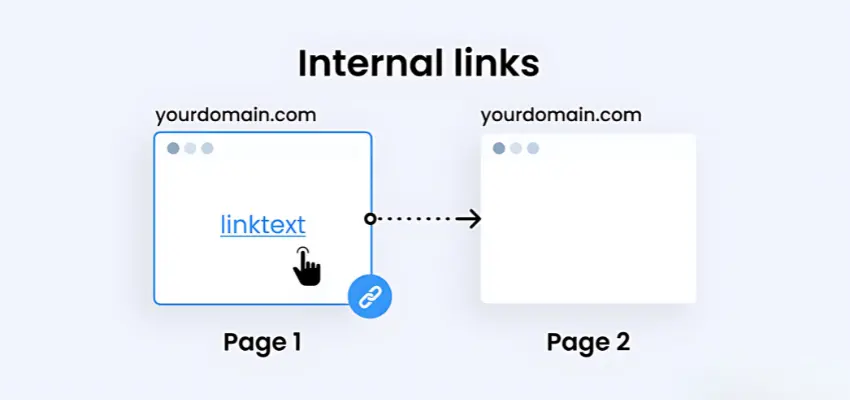What is Internal Linking in SEO?
Internal linking is the process of linking one page of your website to another page on the same domain. These links help search engines and users navigate your site efficiently, improving crawlability, user experience, and SEO performance.
Why is Internal Linking Important for SEO?
Internal linking plays a crucial role in website optimization by:
Improving Crawlability & Indexation: Search engines like Google use internal links to crawl and index pages more efficiently (SEO Basics to gain a solid foundation on search engine optimization.).
Distributing Link Equity: Internal links help spread page authority (link juice) across your site, boosting rankings.
Enhancing User Experience: A well-structured internal linking strategy makes it easier for users to find relevant content, reducing bounce rates.
Preventing Orphan Pages: Internal linking ensures that no pages are left unlinked, making them easier to discover and rank (Orphan Pages to understand why pages without links can harm your SEO.).
Boosting Keyword Rankings: Strategic anchor text in internal links helps search engines understand page relevance to specific keywords (Effective Keyword Research for insights on choosing the right keywords for internal linking.).

Types of Internal Links
1. Navigational Links
These are links in menus, footers, and sidebars that help users navigate your site’s main sections.
2. Contextual Links
These are links embedded within your content that direct users to related articles, blogs, or pages for additional information.
3. Breadcrumbs
Breadcrumb navigation shows users their location on your site, improving structure and usability.
4. Footer Links
Footer links provide additional navigation options and help connect important pages for SEO benefits.
Best Practices for Internal Linking in 2025
1. Use Descriptive and Keyword-Rich Anchor Text
Anchor text should be relevant to the linked page and include keywords naturally. For example, instead of “click here,” use “learn more about SEO strategies.”
2. Link to High-Value Pages
Prioritize linking to pages that drive conversions, such as service pages, high-performing blogs, or landing pages.
3. Avoid Excessive Internal Links
Too many links on a page can dilute link equity. Aim for 3-5 internal links per blog post where relevant.
4. Update Old Content with Internal Links
Regularly audit older content and insert links to newer, relevant posts to keep your site interconnected with a well-structured content strategy. A strong internal linking system can enhance your site’s content planning, much like a Content Calendar for SEO helps in organizing blog posts and updates effectively..
5. Use a Logical Site Structure
Your site should follow a hierarchy where category pages link to subcategories and individual posts.
6. Prevent Orphan Pages with Internal Links
Ensure every page on your site has at least one internal link pointing to it. Read more about orphan pages.
7. Optimize Internal Links for Mobile Users
Make sure links are easy to tap on smaller screens and maintain a clean, user-friendly mobile experience.
Common Internal Linking Mistakes to Avoid
Using Too Many Links in One Post – This can overwhelm users and confuse search engines.
Linking to Irrelevant Pages – Every link should provide additional value to the reader.
Using the Same Anchor Text for Different Pages – This can confuse search engines about which page should rank for a keyword.
Not Updating Broken or Outdated Links – Broken links harm user experience and SEO performance.
Failing to Link to Deep Pages – Don’t just link to your homepage; ensure deep pages also receive link equity (SEO-Friendly Website Architecture to build a site that naturally supports internal linking.).
How to Audit and Improve Your Internal Linking Structure
1. Use SEO Tools to Identify Internal Links
Tools like Screaming Frog, Ahrefs Site Audit, or Google Search Console can help analyze internal links and spot issues.
2. Check for Orphan Pages
Review your site structure to find and fix orphan pages.
3. Implement a Content Hub Strategy
Group related content into clusters with a pillar page linking to subtopics for better SEO impact (Topic Clusters to create a content structure that strengthens internal linking.).
4. Use Internal Links to Boost Low-Traffic Pages
Identify underperforming pages and link to them from high-traffic articles to increase their visibility (Dwell Time in SEO to learn how internal linking can improve user engagement and rankings.).
FAQs About Internal Linking in SEO
1. How many internal links should I use in a blog post?
Aim for 3-5 internal links per post, ensuring they are relevant and add value.
2. Can too many internal links hurt SEO?
Yes, excessive links can dilute link equity and confuse search engines. Keep it natural and user-friendly.
3. How do I find broken internal links on my site?
Use tools like Google Search Console, Ahrefs, or Screaming Frog to scan for broken links.
4. Should I use exact-match anchor text for internal links?
Not always. Mix exact-match keywords with natural phrases to avoid over-optimization.
5. How often should I audit my internal links?
Conduct a full internal link audit every 3-6 months to ensure an optimized and well-connected site structure.
Final Thoughts
Internal linking is a powerful SEO strategy that enhances website structure, boosts rankings, and improves user experience. By following best practices and regularly auditing your internal links, you can optimize your website for both search engines and users.
Want to improve your internal linking strategy and boost rankings? Get a free website audit from CG Marketing today!
